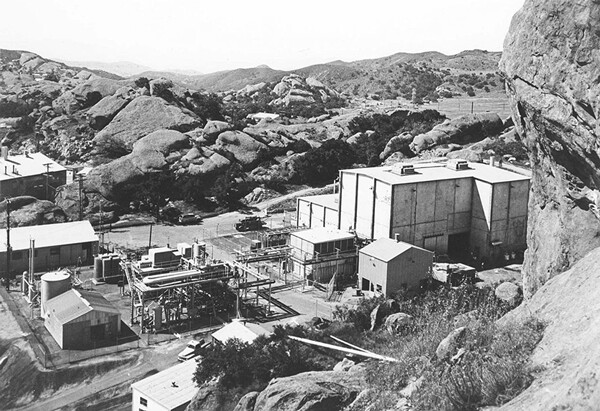The Tip of the Radiation Disaster Iceberg

The World Nuclear Association says its goal is “to increase global support for nuclear energy,” and it repeatedly claims on its website: “There have only been three major accidents across 16,000 cumulative reactor-years of operation in 32 countries.” The WNA and other nuclear power supporters acknowledge Three Mile Island in 1979 (US), Chernobyl in 1986 (USSR), and Fukushima in 2011 (Japan) as “major” disasters. But claiming that these radiation gushers were the worst ignores the frightening series of large-scale disasters that have been caused by uranium mining, reactors, nuclear weapons, and radioactive waste. Some of the world’s other major accidental radiation releases indicate that the Big Three are just the tip of the iceberg.
CHALK RIVER (Ontario), Dec. 2, 1952: The first major commercial reactor disaster occurred at this Canadian reactor on the Ottawa River when it caused a loss-of-coolant, a hydrogen explosion and a meltdown, releasing 100,000 curies of radioactivity to the air. In comparison, the official government position is that Three Mile Island released about 15 curies, although radiation monitors failed or went off-scale.
ROCKY FLATS (Colorado), Sept. 11, 1957: This Cold War factory produced plutonium triggers for nuclear weapons 16 miles from Denver. It caused 30 to 44 pounds of breathable plutonium-239 and plutonium-240 to catch fire in what would come to be known as the second largest industrial fire in US history. Filters used to trap the plutonium were destroyed and it escaped through chimneys, contaminating parts of Denver. Nothing was done to warn or protect downwind residents.
WINDSCALE/SELLAFIELD (Britain), Oct. 7, 1957: The worst of many fires burned through one reactor igniting three tons of uranium and dispersed radionuclides over parts of England and northern Europe. The site was hastily renamed Sellafield. Another large radiation leak occurs in 1981and leukemia rates soared to triple the national average.
KYSHTYM/CHELYABINSK-65 (Russia), Sept. 29, 1957: A tank holding 70 to 80 metric tons of highly radioactive liquid waste exploded, contaminating an estimated 250,000 people, and permanently depopulating 30 towns which were leveled and removed from Russian maps. Covered up by Moscow (and the CIA) until 1989, Russia finally revealed that 20 million curies of long-lived isotopes like cesium were released, and the release was later declared a Level 6 disaster on the International Nuclear Event Scale. The long covered-up explosion contaminated up to 10,000 square miles making it the third- or 4th-most serious radiation accident ever recorded.
SANTA SUSANA (Simi Valley, Calif.), July 12, 1959: The meltdown of the Sodium Reactor Experiment just outside Los Angeles caused “the third largest release of iodine-131 in the history of nuclear power,” according to Arjun Makhajani, President of the Institute for Energy & Environmental Research. Released radioactive materials were never authoritatively measured because “the monitors went clear off the scale,” according to an employee. The accident was kept secret for 20 years.
CHURCH ROCK (New Mexico), July 16, 1979: Ninety-three million gallons of liquid uranium mine wastes and 1,000 tons of solid wastes spilled onto the Navajo Nation and into Little Puerco River, and nuclear officials called it “the worst incident of radiation contamination in the history of the United States.” The Little Puerco feeds the Little Colorado River, which drains to the Colorado River, which feeds Lake Mead—a source of drinking water for Los Angeles.
TOMSK-7 (Russia), April 7, 1993: In “the worst radiation disaster since Chernobyl,” Russian and foreign experts said a tank of radioactive waste exploded at the Tomsk nuclear weapons complex and that wind blew its plume of radiation toward the Yenisei River and 11 Siberian villages, none of which were evacuated.
MONJU (Japan), Dec. 8, 1995: This sodium-cooled “breeder reactor” caused a fire and a large leak of sodium coolant into the Pacific. Liquid sodium coolant catches fire on contact with air and explodes on contact with water. Costly efforts to engineer commercial models have failed. Japan’s Monju experiment was halted in 2018 after over 24 years of false starts, accidents and cover-ups.
TOKAI-MURA (Japan), Sept. 30, 1999: A uranium “criticality” which is an uncontrolled nuclear chain reaction caused a “neutron burst” that killed three workers and dispersed neutron radiation throughout the densely populated urban area surrounding the factory.
Not to be slighted, deliberate contamination has also been enormous: Five metric tons of plutonium was dispersed over the earth by nuclear bomb testing, and other nuclear weapons processes; Over 210 billion gallons of radioactive liquids were poured into the ground at the Hanford reactor complex in Washington State; and 16 billion gallons of liquid waste holding 70,000 curies of radioactivity were injected directly into Idaho’s Snake River Aquifer at the Idaho National Lab.